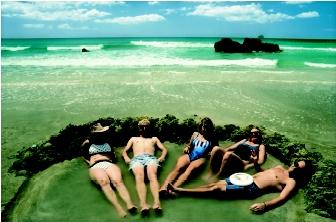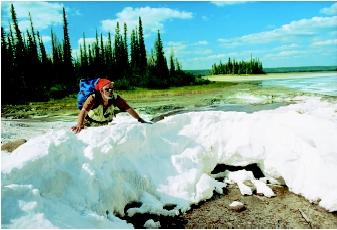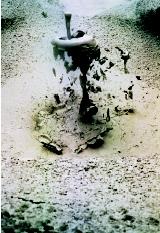Springs
A spring is a location where groundwater naturally emerges from the Earth's subsurface in a defined flow and in an amount large enough to form a pool or stream-like flow. Springs can discharge fresh groundwater either onto the ground surface, directly into the beds of rivers or streams, or directly into the ocean below sea level. * Springs form the headwaters of some streams.

Flow from a spring can range from barely detectable (in which case the spring is usually called a seep) to more than 30 cubic meters per second, which is about 30,000 liters (7,900 gallons) each second. Temperatures of spring water range from near water's freezing point to its boiling point.
Human Interest in Springs
Springs have captured the imagination of scientists and philosophers for thousands of years. In fact, many of the earliest ideas about the hydrologic cycle were inspired as people tried to understand the source of spring water. For many people, springs are the most obvious and interesting evidence of groundwater. Spring water also has practical uses. For example, in arid regions, springs have played a role in determining where humans have chosen to settle.
Spring water also is associated in the public's mind with exceptional quality, and bottled spring water is a booming business. Spring waters, particularly those from mineral and hot springs, have long been believed to possess therapeutic and medicinal value. However, no scientific evidence exists regarding their medicinal value. To the contrary, water from hot springs often contains large amounts of toxic dissolved materials, such as arsenic, that have leached from underground layers of rocks.
How Springs Form
Most of the water that emerges at springs is meteoric in nature: that is, it originally fell as rain or snow on the surface of the Earth. At hot springs near active volcanoes, some of the water may have originated from magma, molten rock that also contains dissolved substances such as water. As magma cools and crystallizes in the Earth's crust, it releases much of this water. Spring water also can be ancient sea water, although it usually is diluted with meteoric water.
Conceptually, the groundwater system associated with springs is simple. It consists of:
- A recharge area where water enters the subsurface;
- An aquifer or set of aquifers through which the water flows; and
- A discharge point where water emerges as a spring.
The existence of a spring requires that below the surface (the area commonly called the subsurface), the infiltrating water encounters a low permeability zone and is unable to continue to move downward as fast as it is supplied at the surface; as a result, the water spreads laterally until it intersects the land surface where erosion has lowered the topography to the water's level (e.g., on the side of a canyon). *
A range of geological structures and topographic features can direct water to the surface and form a spring. Many seeps and small springs are associated with topographic depressions where the water table intersects the Earth's surface. Larger springs usually are formed where geological structures, such as a faults and fractures, or layers of low-permeability material, force large amounts of water to the surface.
Characteristics of Springs
Springs may be considered curious features because water appears to flow directly out of rocks. Yet springs are less mysterious when one understands where the water came from and how long it has been in the subsurface.
Origin of the Water.
The question of where the water came from is specifically asking from what region the water originates—commonly termed the recharge area. The recharge area is usually, but not always, surrounded or outlined by topographic highs such as ridges and mountaintops. It is within the recharge area where the water, generally from precipitation, sinks below the surface and travels to the spring. *
Age of the Water.
The question of how old the water is (i.e., the water's age) refers to the amount of time that the water was located in the subsurface before emerging at the spring. Water enters the ground at different locations and moves at different speeds. The age of the spring water is thus defined as the average time the water spent in the subsurface before emerging as a spring.
Water ages can be estimated with chemical tracers , provided the chemical behavior of tracers in the subsurface is known. One example of a useful tracer is tritium, a radioactive form of hydrogen. Tritium decays radioactively to helium at a known rate. By measuring the relative abundance of tritium and helium produced by the decay of tritium, it is possible to determine the age of the water.
If recharge rates to the groundwater system are low (as they are in arid regions), and the distances traveled by the water are great, then the age of spring water can be large. Some of the springs in arid Nevada may be discharging water with average ages of hundreds to thousands of years.
In general, when water age is old, variations in the flow of water from the spring will be small. In contrast, springs with large variations in flow

Temperature.
The temperature of spring water is related to the amount and rate of groundwater flow. As depth below the Earth's surface increases, temperature increases. As a result, deep circulating groundwater can be warmed. If groundwater velocities are low and the springs are small, most of the heat will be conducted though the rocks and the water will remain cold. If the springs are large, the spring water also will be cold because the volume of water is too great to be adequately warmed. The warmest springs occur when discharges are moderately large, and often are found in regions where the subsurface is unusually warm, such as volcanically active areas. *
As groundwater flows to a spring, its composition and temperature may change depending on the materials through which the water flows, the length of time the water is below the surface, and the geological setting. Springs provide access to water that has reacted with rocks in the subsurface at distant regions, and in some cases, in distant periods of time. Spring water can thus provide an opportunity to obtain information about subsurface geological and hydrological processes. In regions with no wells or boreholes, spring water may be one of the only sources of information about the subsurface.
Large-Volume Springs
The geologic setting of a region determines whether a spring will occur, whether it will be small or large, and what the characteristics of its water

- Recharge area must be large and/or recharge rate must be high so that large volumes of water can enter the groundwater system; and
- Aquifer permeability must be large so that water flow can be concentrated in a relatively small area.
These conditions are most often satisfied either in volcanically active regions with young volcanic rocks (such as the Oregon and California Cascades), or in karst terrain where subterranean passages are dissolved in carbonate rocks, often limestone.
An example of a large spring is the one from which the Metolius River in the Cascade Mountains of central Oregon abruptly appears. The Metolius Spring discharges more than 3 cubic meters (100 cubic feet) per second, which is equivalent to 792 gallons every second, and at a temperature that is at a nearly constant 9°C (48°F). This rate of discharge is also equivalent to nearly all the precipitation that falls in the spring's 400-square kilometer (154-square mile) recharge area. The groundwater flows through young lava flows and is brought back to the surface along a large fault.
SEE ALSO Bottled Water ; Cavern Development ; Earth's Interior, Water in the ; Fresh Water, Natural Composition of ; Geothermal Energy ; Groundwater ; Hot Springs and Geysers ; Isotopes: Applications in Natural Waters ; Karst Hydrology ; Life in Extreme Water Environments ; Mineral Waters and Spas ; Tracers in Fresh Water.
Michael Manga
Bibliography
Chapelle, Frank, James E. Landmeyers, and Francis H. Chapelle. The Hidden Sea: Ground Water, Springs, and Wells. Tucson, AZ: Geoscience Press, 1997.
Lamoreaux, Philip E., and J. T. Tanner, eds. Springs and Bottled Waters of The World: Ancient History, Source, Occurrence, Quality, and Use. New York: Springer-Verlag, 2001.
Manga, Michael. "Using Springs to Study Groundwater Flow and Active GeologicProcesses." Annual Reviews of Earth and Planetary Sciences 29 (2001):203–230.
Meinzer, M. O. Large Springs in the United States. U.S. Geological Survey, WaterSupply Paper 557 (1927).
Waring, G. A., R. R. Blankenship, and R. Bentall. Thermal Springs in the United States and Other Countries of the World; A Summary. U.S. Geological Survey, Professional Paper 492 (1965).
* Photographs of hot springs occur in the following entries: "Fresh Water, Natural Composition of;" "Hot Springs and Geysers;" and "Life in Extreme Water Environments."
* See "Groundwater" for a generalized diagram showing a recharge area to aquifers.
* See "Groundwater" for a schematic of a gravity spring.
* See "Lakes: Chemical Processes" for a photograph of a saline lake with a lakebed spring.
Comment about this article, ask questions, or add new information about this topic: